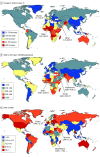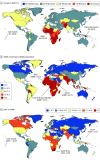Global, Regional, and National Incidence and Mortality of Neonatal Preterm Birth, 1990-2019
- PMID: 35639401
- PMCID: PMC9157382
- DOI: 10.1001/jamapediatrics.2022.1622
Global, Regional, and National Incidence and Mortality of Neonatal Preterm Birth, 1990-2019
Abstract
Importance: Preterm birth complications are the leading cause of death in children younger than 5 years worldwide. Despite advancing knowledge of risk factors and mechanisms related to preterm labor, the preterm birth rate has risen in most industrialized countries. Moreover, the burden of neonatal preterm birth remains unclear across the world.
Objective: To determine the trends in incidence and mortality of neonatal preterm birth at the global, regional, and national levels to quantify its burden from 1990 to 2019 using data from the 2019 Global Burden of Disease study.
Design, setting, and participants: Annual incident cases, deaths, age-standardized incidence rates (ASIRs), and age-standardized mortality rates (ASMRs) of neonatal preterm birth between 1990 and 2019 were collected from the 2019 Global Burden of Disease study. The percentage of relative changes in incident cases and deaths as well as the estimated annual percentage changes (EAPCs) of ASIRs and ASMRs were calculated to quantify their temporal trends. Correlations of EAPC of ASIRs and ASMRs with sociodemographic index (SDI) and universal health coverage index were evaluated by Pearson correlation analyses.
Exposures: Infants born alive before 37 completed weeks of gestation between 1990 and 2019.
Main outcomes and measures: Incident cases, deaths, ASIRs, and ASMRs of neonatal preterm birth.
Results: Globally, the incident cases of neonatal preterm birth decreased by 5.26% from 16.06 million in 1990 to 15.22 million in 2019, and the deaths decreased by 47.71% from 1.27 million in 1990 to 0.66 million in 2019. The overall ASIR (EAPC = -0.19 [95% CI, -0.27 to -0.11]) and ASMR (EAPC = -2.09 [95% CI, -1.99 to -2.20]) decreased in this period. The ASIR of neonatal preterm birth increased by a mean of 0.25% (95% CI, 0.13%-0.38%) in high-SDI regions from 1990 to 2019. The ASMR of neonatal preterm birth increased by a mean of 2.09% (95% CI, 1.99%-2.20%) in Southern Sub-Saharan Africa in this period. A positive correlation was observed between EAPC of ASIR and SDI or universal health coverage index in 2019, while a negative correlation was observed between EAPC in ASMR and SDI or universal health coverage index in 2019 at national levels.
Conclusions and relevance: Preterm birth remains a crucial issue in children worldwide, with an increasing trend in ASIR in high-SDI regions and in ASMR in Southern Sub-Saharan Africa between 1990 to 2019. Efforts to reduce both the incidence and mortality of preterm births are essential.
Conflict of interest statement
Figures



References
-
- World Health Organization . Preterm birth. Published February 19, 2018. Accessed January 1, 2022. https://www.who.int/news-room/fact-sheets/detail/preterm-birth
-
- World Health Organization . WHO recommendations on interventions to improve preterm birth outcomes. Published November 1, 2015. Accessed January 1, 2021. https://www.who.int/publications/i/item/9789241508988 - PubMed
Publication types
MeSH terms
LinkOut - more resources
Full Text Sources
Medical

